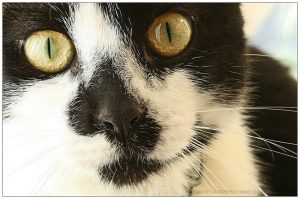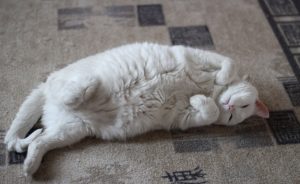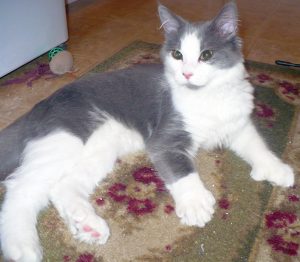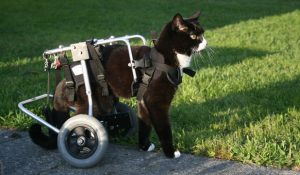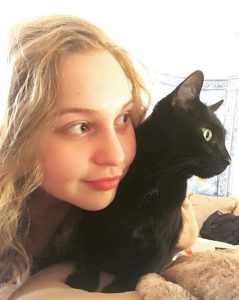We love our pets! One of the reasons why we have family dogs and or cats is to experience a close bond with a furry family member who love you unconditionally. Unfortunately, not all pets receive this love or bond with humans because they have birth defects or past injuries making them handicapped. Naturally, humans like to look at what is beautiful and attractive. But what is also natural are birth defects, and accidents can affect animal’s ability to do basic actions. Many animals are not adopted or cared for because of these defects. In the same manner that someone would not ignore a blind woman crossing the street, many people are choosing to care for cats with birth defects or who have suffered from injuries leaving them handicapped. In this article, I’ll go over some disabilities that cats can have, some advice of how to care for your loving special-needs kitty, and some stories of amazing and kind cat owners who provide their kitty the best and happiest life they can possibly have.
Three Legs
When you bring a cat into your home, you are accepting a large amount of responsibility, patience, and work. However, when you have a three-legged cat, they will require extra care and caution. In some cases, cats are born with three legs. This can happen if the umbilical cord is wrapped around one of their limbs, cutting off circulation. However, in other cases, a cat may be born with a deformity that results in the loss of one of their limbs. Most three-legged cats have had a leg amputated because of injury or a past illness.
Any pet will have a difficult time adjusting to life on three legs, unless they were born missing a limb. Adapting to three legs will be difficult for cat and it will cause more work for you. Keep in mind that your cat may feel depressed and be very inactive. They may also suffer from phantom limb syndrome and feel as if their missing limb is in extreme pain. Your cat may feel confused and think they can still count on their missing leg when jumping or climbing. With enough love, gentle petting, space, and help from YOU, your cat should return to who they were before, just with one less appendage.
- Your cat used to jump from the recliner to the coffee table and make their way onto the top of a 5-foot cat tree without hesitation. Now, your cat will have issues with what used to be routine. Rearrange the furniture to enable your cat to move from one piece to another so they can still enjoy the travel and get to the top of their cat tree safely. For example, provide small pet steps against the side of your bed or against the cushion of the couch so you cat can still reach their favorite places.
- Begin playing with your cat with toys when their mood brightens up to help them become more active and to strengthen their remaining limbs.
- Using the litter box may be a challenge for your cat, too, because the step into the litter box or a cover concealing the space can be intimidating for them. You may have to help your cat into the litter box at first and be there to make sure they can keep their balance while they use the restroom, cover their feces and urine, and clean themselves afterwards.
- Don’t overfeed your cat. They may become depressed and try to comfort themselves with food and weight gain can become an issue. Feed them as you normally would.
- Accept your emotions and your cat’s. As you give your pet physical, moral and metal support, allow yourself to be comforted in someway, too.
Extra Toes
If your cat has extra toes, that is because that’s just how they were born. And who doesn’t love kitty toes?! I know I love their cute little toes. If your cat has extra toes, they are considered a Polydactyl Cat (or a Hemingway cat because he was a HUGE cat lover and had more than fifty cats, half with extra toes). Essentially, what happens in utero to cause this is when a kitten inherited the autosomal dominant trait of the ZRS cic element of the PD gene with an incomplete penetrance. Lots of big, confusing words; let me break it down for you. Autosome is a chromosome that is not a sex chromosome, and when ZRS cic element of PD gene was not in proportion to the mother or father cat carrying a certain variant of a gene that is because the gene had either an incomplete or reduced penetrance.
Cats normally have eighteen toes, with five toes on each front paw and four toes on their back paws. Some kitties with extra toes can have as many as twenty-eight toes! Not much has to be done to make sure your cat’s toes aren’t injured other than being extra cautious about them. They can occasionally be surgically removed based on their location and the health hazards they may possess. Extra toes are often unusable and can easily get snagged on fabrics which could hurt the toe. Be extra careful when checking their paws for any splinters or cuts so you don’t spread their toes too far apart. You don’t want to cause any injury while making sure your cat is okay.
Cleft Palates
Cats can be born with cleft palates just like humans can. A cleft palate is an abnormal opening in the roof of the mouth and it occurs because the two sides of the roof of the mouth (the palate) did not come together and fuse during the embryonic development while your cat was in utero. This results in an opening between the nasal passages and the mouth. Some symptoms that your cat can experience include: a runny nose, a lack of appetite, coughing, weight loss, pneumonia (caused by liquids and food entering the cleft and infecting your cat’s lungs), difficulty nursing, and respiratory issues. If you have a kitten that was born with a cleft palate, you should take them to your veterinarian as quickly as possible. Your kitten and momma cat may have to stay at the vet for a while so they can monitor your kitten’s health while continuing to enforce a bond with their mother and allowing them to nurse. Your veterinarian will probably suggest surgery to repair the birth defect, but it is often postponed until your kitten is three to four months old. Keep in mind that multiple surgeries are typically necessary for the total closure of the palate.
Spina Bifida
For those of you who are not familiar with Spina Bifida, it is a condition that can affect dogs, cats, and humans. Spina Bifida is caused when the spinal cord is left exposed at birth because the vertebrae did not completely grow around the spinal cord. The condition can range from a small portion of your cat’s spinal cord being exposed to the entire spinal cord being exposed. This is typically discovered through x-ray. If their lower-back is affected, this leads to the diagnosis of Spina Bifida. Some symptoms of this birth defect are great to little hind limb weakness or frequent stumbling when your cat walks. Other symptoms include: cavity or swelling of the spine, a buildup of fluid in the spine that can lead to infection and swelling, limping, and neurological signs like paralysis or seizures. Your cat may also have a hard time using the restroom if they don’t have the strength to properly hold their own body weight.
Unfortunately, there is not much of a treatment for extreme cases of Spina Bifida for cats. Kittens and puppies are often euthanized when they are diagnosed. However, some owners of cats with Spina Bifida have been able to provide their cats with happy lives. With frequent trips to the veterinarian to make sure your cat is doing well, getting antibiotics if needed, and giving them a soft diet to make it easier for them to go to the bathroom, your cat can live a happy, fulfilling life. To give your cat more independence, you can always buy a pair of Wheel Cats for your cat’s rear legs. They know their limits and will be grateful that you have given then the opportunity to run around the house and play with you just like a regular cat would.
Cats with special needs should be given a chance to have a good life, just like their healthy counterparts. Consider adopting a special needs cat because you might be just what they need to have a happy, fulfilled life. Odds are, they’ll make your life a brighter, happier, more loving place, too.
Elanda-Isabella Atencio, our Feline Editor, is on her road to being a “crazy” cat lady. She has three cats; a moody Missus, a wild Baby Kitty, and notorious Fredrick Douglass. She was raised with cats, chickens, dogs, and geese. From cleaning coops, morning dog runs, picking eggs, to growing catnip, Elanda enjoys pampering her pets. Elanda is a student at New Mexico State University, earning her BA in Creative Writing and is Editor-in-Chief of the online arts journal, Independent Noise and reader for Puerto del Sol. She plans to move to Oregon, where she hopes to take her cats on daily walks when it’s overcast and cool. If you’d like to contact Elanda, email her at eincatencio@gmail.com.

